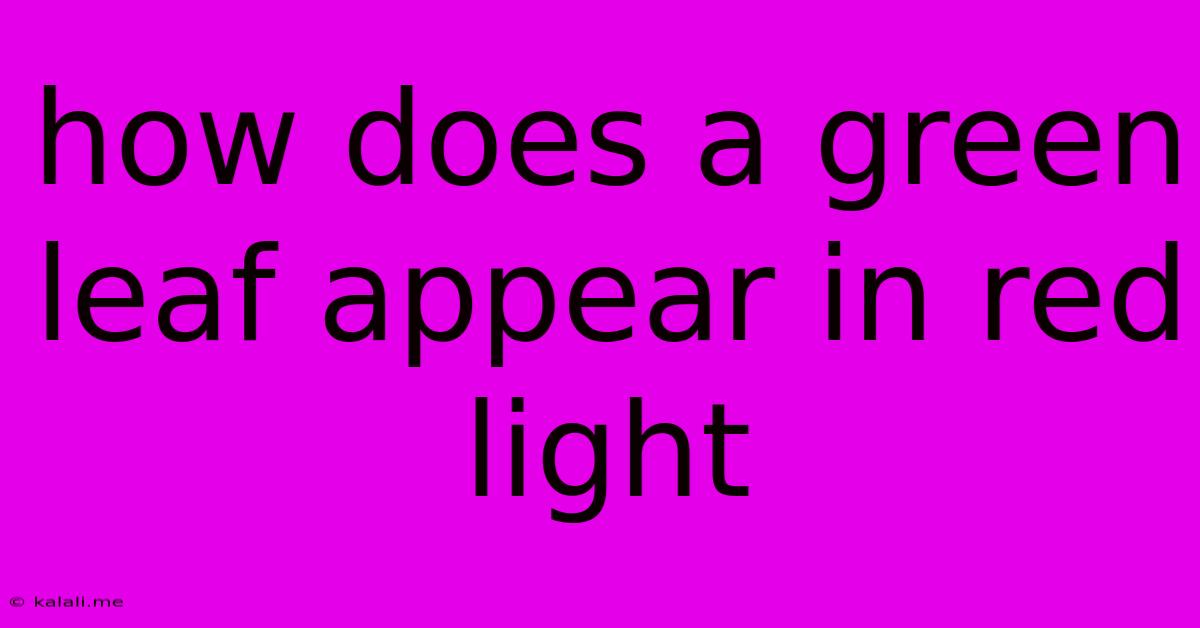How Does A Green Leaf Appear In Red Light
Kalali
Jun 12, 2025 · 3 min read

Table of Contents
How Does a Green Leaf Appear in Red Light? The Science of Light Absorption and Reflection
Have you ever wondered what happens to the vibrant green of a leaf when you shine a red light on it? The answer lies in the fascinating world of photosynthesis and the way plants interact with light. This article will delve into the science behind why a green leaf, under red light, might appear surprisingly dark or even black, rather than retaining its characteristic green hue.
Understanding Chlorophyll and Light Absorption
Plants appear green because of chlorophyll, the pigment responsible for capturing light energy during photosynthesis. Chlorophyll absorbs light most efficiently in the blue and red regions of the visible light spectrum, reflecting green light. This reflected green light is what our eyes perceive.
Chlorophyll a and Chlorophyll b are the two main types of chlorophyll found in plants. They absorb light at slightly different wavelengths, broadening the range of light the plant can utilize for photosynthesis. The absorption peaks of these chlorophylls are in the blue and red regions; minimal absorption occurs in the green region.
Red Light and Chlorophyll's Response
When a red light illuminates a green leaf, the chlorophyll molecules readily absorb the red light photons. This energy is then used to power the process of photosynthesis, converting carbon dioxide and water into glucose (sugar) and oxygen. Because the red light is being absorbed and utilized, very little is reflected back to our eyes.
Why Doesn't It Appear Red?
You might expect the leaf to appear red because the light source is red. However, the leaf isn't reflecting the red light; it's absorbing it. The lack of reflected light makes the leaf appear much darker than it does under white light, which contains all the wavelengths of the visible spectrum. In essence, the leaf appears dark, almost black, because most of the light energy is being consumed, rather than reflected.
Other Factors Affecting Appearance
The exact appearance of a leaf under red light can be influenced by several factors, including:
- Intensity of the red light: A brighter red light might cause the leaf to appear slightly darker than a dimmer red light.
- Type of leaf: Different plant species have varying chlorophyll concentrations and types, potentially affecting the exact shade observed under red light.
- Health of the leaf: A stressed or unhealthy leaf may exhibit different absorption characteristics, possibly altering its appearance under red light.
- Presence of other pigments: Besides chlorophyll, leaves contain other pigments like carotenoids and anthocyanins, which absorb and reflect light at different wavelengths. These pigments could slightly influence the final perceived color under red light, though their effect would likely be minor compared to the dominance of chlorophyll.
Conclusion:
A green leaf appears dark, often nearly black, under red light because the chlorophyll within the leaf absorbs the red light for photosynthesis, rather than reflecting it. This absorption process is fundamental to the plant's ability to convert light energy into chemical energy, highlighting the intricate relationship between light, pigments, and the life processes of plants. Understanding this interaction showcases the elegance and efficiency of nature's design.
Latest Posts
Latest Posts
-
Relation Between Degree Celsius And Fahrenheit
Jun 13, 2025
-
What Is The Difference Between A Quota And A Tariff
Jun 13, 2025
-
1gb Is Equal To How Many Kilobytes
Jun 13, 2025
-
Which Of The Following Is The Fundamental Unit Of Life
Jun 13, 2025
-
During Human Gestation Rudiments Of All Organs Develop
Jun 13, 2025
Related Post
Thank you for visiting our website which covers about How Does A Green Leaf Appear In Red Light . We hope the information provided has been useful to you. Feel free to contact us if you have any questions or need further assistance. See you next time and don't miss to bookmark.